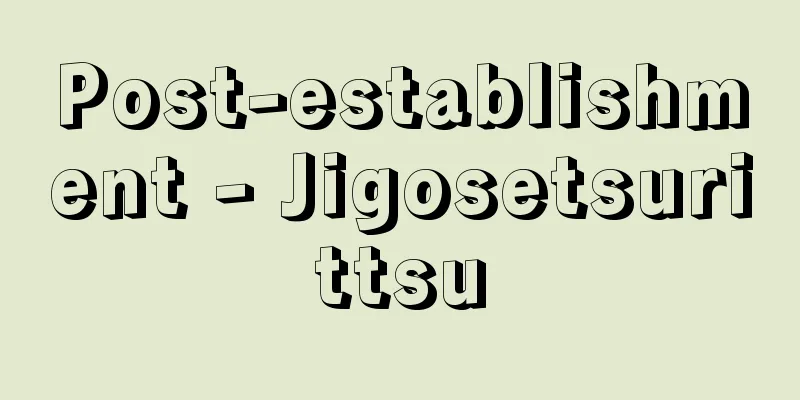Land tax - Chiso

|
It is sometimes used as a general term for taxes imposed on land, but generally it refers to taxes imposed on land as a result of the land tax reform in the early Meiji period. Japan's modern tax system began in the Meiji period, but the land tax was inherited from the Edo period as a tax with a strong feudal character, and was fundamentally revised by the Land Tax Reform Ordinance of 1873 (Meiji 6) and the Land Tax Reform Project completed in 1881. As a result, in the new system, the land price was used as the tax base, payment in kind was changed to payment in money, and the taxpayer was changed from the cultivator to the landowner. The tax rate was levied at a fixed rate of 3/100 of the land price regardless of whether the harvest was good or bad (this rate has been changed many times since then), and the system was unified nationwide. This reform enabled the government to secure stable tax revenue, and on the other hand, the assessment of land prices was unified nationwide, which maintained fairness in the burden on taxpayers and established land ownership. In 1884, the Land Tax Reform Ordinance was abolished and the Land Tax Ordinance was enacted, which served as the basic law for land tax for a long time thereafter. Throughout the Meiji period, land tax was the main source of tax revenue for the country, and in 1873, when it reached its peak, it accounted for 93.2% of the total tax and stamp revenue of the country. After that, as other modern taxes were introduced, the percentage gradually decreased, and by 1911 (Meiji 44), it was 17.8%. In 1931 (Showa 6), the Land Tax Ordinance was abolished and the Land Tax Law was enacted, and the land tax was levied on the rental price instead of the land price. In 1940, it became a refund tax in the local allocation tax, and in 1947 (Showa 22) after World War II, the Land Tax Law was abolished and the land tax was transferred from a national tax to a prefectural tax. Then, in 1950, with the revision of the local tax system based on the Shoup recommendations, the land tax was abolished and incorporated into the fixed property tax, a municipal tax. [Masatoshi Hayashi] [Reference] | |Source: Shogakukan Encyclopedia Nipponica About Encyclopedia Nipponica Information | Legend |
|
土地に対して課される租税の総称として用いられることもあるが、一般には明治初年の地租改正によって土地に課されることとなった租税をいう。わが国の近代租税制度は明治時代に始まるが、地租は封建的性格の強い租税として江戸時代から引き継がれたもので、1873年(明治6)の地租改正条例によって開始され、81年に完了した地租改正事業により根本的な改正が加えられた。その結果、新制度においては、地価が課税標準とされ、物納から金納に、納税義務者は耕作者から地主にかえられた。税率は、豊作・凶作にかかわらず地価の100分の3という定率(この率はその後しばしば変更された)で課されるようになるとともに、制度が全国的に統一された。この改正によって政府は安定した税収を確保できるようになり、他方、全国的に統一的な地価の評価が行われることにより、納税者にとっても負担の公平が維持されるとともに、土地の所有権も確立された。1884年には地租改正条例が廃止されて地租条例が制定され、以後長い間、地租の根拠法規となった。 明治時代を通じて、地租は国の主要税収源であり、その割合がもっとも高かった1873年には国の租税および印紙収入総額の93.2%にも及んだ。その後、ほかの近代的租税が導入されるとともにその割合はしだいに低下し、1911年(明治44)には17.8%となった。1931年(昭和6)には地租条例が廃止されて地租法が制定され、地租はこれまでの地価にかわって賃貸価格に課されることになった。1940年には地方分与税中の還付税となり、第二次世界大戦後の1947年(昭和22)には地租法が廃止され、地租は国税から地方税である府県税へ移行された。ついで1950年のシャウプ勧告に基づく地方税制の改正に伴って地租は廃止され、市町村税である固定資産税の一部に組み込まれた。 [林 正寿] [参照項目] | |出典 小学館 日本大百科全書(ニッポニカ)日本大百科全書(ニッポニカ)について 情報 | 凡例 |
Recommend
Lake Inmen - Inmenko
…Throughout this time, he continued his literary ...
Flexed burial - Kusso
A burial method in which the body is buried with ...
Perahera
…Although it has undergone many changes since the...
Old songs - Kokyoku
〘Noun〙① Refers to the whole of old music, as oppos...
Béjart, Maurice
Born: January 1, 1927, Marseille, France [Died] No...
Petrazhitskiy (English spelling) Lev Iosifovich Petrazhitskiy
1867‐1931 A leading Russian legal scholar. After g...
Barbus semifasciolatus (English spelling)
...The species listed here are omnivorous, eat bo...
Grain weevil (Sitophilus zeamais)
An insect of the family Curculionidae (illustratio...
Speculum majus (English spelling)
…There are also documents that, although not orig...
Homoptera
…A general term for arthropods belonging to the o...
Numbers - Numbers
〘noun〙① Something that is numerous. Also, somethin...
SP (record) - SP
...This method is still used in modern records, a...
Country elevator - Country elevator (English spelling)
A facility in a grain-producing area that collect...
Rice Price Deliberation Council
This was an advisory body established in the Food...
Allium
A general term for the Allium genus in the Liliac...









